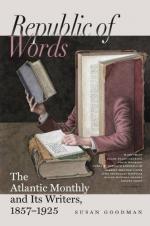all the shots are close together, you may be sure the
gun shoots well, though they may be at considerable
distance from the bull’s-eye. That would
only prove that the line of sight was not coincident
with the line of fire, which can be easily rectified
by moving the forward sight to the right or left,
according as the variation was on the one side or
the other. Having fired your string of ten shots,
take a pair of dividers, and, with a radius equal
to half the distance between the two hits most distant
from each other, describe a circle cutting through
the centre of each of those hits. From the centre
of this circle measure the distance to each of the
hits, add these distances together and divide the
sum by ten, and you have the average variation, which
ought not to be over two inches at the utmost, and
if the gun is what it ought to be, and fired by a
good marksman, would probably be much less. This
is a sufficient test of the precision for that distance,
and the same method may be adopted for longer ranges.
But if the gun shoots well at one hundred yards, its
capacity for a longer range may be proved by its penetrating
power. Provide a number of pieces of seasoned
white-pine board, one inch thick and say two feet
long by sixteen inches wide. These are to be
secured parallel to each other and one inch apart by
strips nailed firmly to their sides, and must be so
placed that when shot at the balls may strike fairly
at a right angle to their face. Try a number
of shots at the distance of one hundred yards, and
note carefully how many boards are penetrated at each
shot. The elongated shots are sometimes turned
in passing through a board so as to strike the next
one sideways, which of course increases the resistance
very greatly, and such shots should not be counted;
but if you find generally that the penetration of
those which strike fairly is not over six inches,
you may rest assured the gun cannot be relied on, except
in a dead calm, for more than two hundred yards, and
with anything of a breeze you will make no good shooting
even at that distance. Nine inches of penetration
is equal to six hundred yards, and twelve inches is
good for a thousand.
A striking proof of the prevailing ignorance of scientific
principles in rifle-shooting is afforded by the fact
that it is still a very common practice to vary the
charge of powder according to the distance to be shot.
The fact is, that beyond a certain point any increase
of the initial velocity of the ball is unfavorable
both to range and precision, owing to the ascertained
law that the ratio of increase of atmospheric resistance
is four times that of the velocity, so that, after
the point is reached at which they balance each other,
any additional propulsive power is injurious.
The proper charge of powder for any rifle is about
one-seventh the weight of the ball, and the only means
which should ever be adopted for increasing the range
is the elevating sight.




